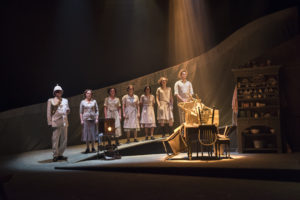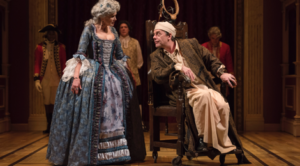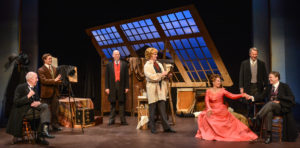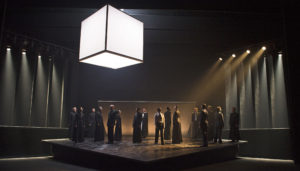 “Because I remember, I despair. Because I remember, I have the duty to reject despair.”
“Because I remember, I despair. Because I remember, I have the duty to reject despair.”
Elie Wiesel, Nobel lecture, 1986
Terry Teachout on the arts in New York City
I was recently informed that my liking for the music of the big-band era proves that I was very happy in my previous life and seek to recreate its pleasures in this one. I don’t know about that, but I do know that the hours I’ve spent listening to and playing in big bands are among the happiest I’ve known….
Read the whole thing here.
In today’s Wall Street Journal drama column, I review two important revivals at Ontario’s Shaw Festival, Dancing at Lughnasa and The Madness of George III. Here’s an excerpt.
* * *
 The Shaw Festival, one of North America’s most ambitious classical theater festivals, is presenting 11 plays and musicals in four different performance spaces this season. After five visits to Niagara-on-the-Lake, the Shaw’s small-town home, I’ve long since learned that its productions are of consistently high quality. But the two shows I saw last week in the 313-seat Royal George Theatre, a renovated 1915 vaudeville house of unrivaled beauty and intimacy, are noteworthy even for the Shaw, and one of them, a perfectly wrought version of “Dancing at Lughnasa,” Brian Friel’s 1990 masterpiece, is a major event by any conceivable standard….
The Shaw Festival, one of North America’s most ambitious classical theater festivals, is presenting 11 plays and musicals in four different performance spaces this season. After five visits to Niagara-on-the-Lake, the Shaw’s small-town home, I’ve long since learned that its productions are of consistently high quality. But the two shows I saw last week in the 313-seat Royal George Theatre, a renovated 1915 vaudeville house of unrivaled beauty and intimacy, are noteworthy even for the Shaw, and one of them, a perfectly wrought version of “Dancing at Lughnasa,” Brian Friel’s 1990 masterpiece, is a major event by any conceivable standard….
A memory play influenced to like degree by Chekhov and “The Glass Menagerie,” “Dancing at Lughnasa” unfolds in and near the cottage of five spinster sisters (Fiona Byrne, Diana Donnelly, Claire Jullien, Sarena Parmar and Tara Roslin) whose uneventful existence is about to be shattered by the coming of modernity. The time is 1936, the place rural Ireland, but there is nothing alien about the plight of the Mundy sisters—they could be from Appalachia or Arkansas—or the tight-knit family life that they share, a life whose closeness cannot survive the centrifugal forces of industrialization, war, and sexual desire….
Ms. Jackson’s staging unfolds in an unadorned, non-realistic playing area designed by Sue LePage whose cheap sticks of furniture are framed by the drab blue-greens and washy blue sky of fading memory. Her ensemble cast, most of whose members are Shaw Festival veterans, performs with a telepathic singleness of purpose….
 As for the Shaw’s production of Alan Bennett’s “The Madness of George III,” it is arguably even more important as an event, since revivals of Mr. Bennett’s 1991 play, a costume piece with two dozen speaking roles, are very rare. (The only important American production in recent years was at San Diego’s Old Globe in 2010.) Kevin Bennett, the director, has contrived to perform “George III” on a smallish stage with 12 actors, a feat of legerdemain that I hope will inspire others to emulate it, though what I’d really like is for this revival to be remounted in New York. Totally different in tone and approach from Nicholas Hytner’s 1994 film version, which was based on the original National Theatre stage production and preserved Nigel Hawthorne’s acclaimed performance of the title role, it’s just as successful in its own distinctive way, and features a sumptuous star turn by Tom McCamus….
As for the Shaw’s production of Alan Bennett’s “The Madness of George III,” it is arguably even more important as an event, since revivals of Mr. Bennett’s 1991 play, a costume piece with two dozen speaking roles, are very rare. (The only important American production in recent years was at San Diego’s Old Globe in 2010.) Kevin Bennett, the director, has contrived to perform “George III” on a smallish stage with 12 actors, a feat of legerdemain that I hope will inspire others to emulate it, though what I’d really like is for this revival to be remounted in New York. Totally different in tone and approach from Nicholas Hytner’s 1994 film version, which was based on the original National Theatre stage production and preserved Nigel Hawthorne’s acclaimed performance of the title role, it’s just as successful in its own distinctive way, and features a sumptuous star turn by Tom McCamus….
* * *
Read the whole thing here.
Watch a time-lapse video that shows how the Shaw Festival’s stage crew strikes the set for Dancing at Lughnasa and prepares the stage of the Royal George Theatre for a performance of The Madness of King George:
In addition to my regular drama column for today’s Wall Street Journal, I’ve also reviewed two regional Shaw revivals, The Doctor’s Dilemma in New Hampshire and Saint Joan at the Shaw Festival, in the paper’s online edition. Here’s an excerpt.
* * *
 In America, the plays of George Bernard Shaw have been increasingly relegated to summer festivals in recent years. Only six have been revived on Broadway in the past quarter-century—a pitifully small showing for a playwright whose work was once a staple of the commercial theater—and many regional companies also steer clear of their big casts and bristling intellectual challenges. That’s one reason why I hit the road at the end of each Broadway season: Shaw was a supremely great theatrical artist whose plays are both thought-provoking and wonderfully funny, and I’m willing to go far out of my way to see his work done well. Up in New Hampshire, Gus Kaikkonen’s Peterborough Players have a long record of doing very well by Shaw, and their latest production, a rare staging of “The Doctor’s Dilemma,” is distinguished even by their own high standards.
In America, the plays of George Bernard Shaw have been increasingly relegated to summer festivals in recent years. Only six have been revived on Broadway in the past quarter-century—a pitifully small showing for a playwright whose work was once a staple of the commercial theater—and many regional companies also steer clear of their big casts and bristling intellectual challenges. That’s one reason why I hit the road at the end of each Broadway season: Shaw was a supremely great theatrical artist whose plays are both thought-provoking and wonderfully funny, and I’m willing to go far out of my way to see his work done well. Up in New Hampshire, Gus Kaikkonen’s Peterborough Players have a long record of doing very well by Shaw, and their latest production, a rare staging of “The Doctor’s Dilemma,” is distinguished even by their own high standards.
First performed in 1906, “The Doctor’s Dilemma” is an uproariously funny comedy about a deadly serious subject. Sir Colenso Ridgeon (David Haugen), the title character, is a newly knighted London physician who finds himself faced with a horrific either-or choice: Should he save the life of a potentially great painter (William Champion) who’s also a sociopathic rogue, or a good-hearted, ne’er-do-well fellow doctor (Cory Buffaloe) who looks after the poor?…
In addition to staging “The Doctor’s Dilemma” with cracker-crisp precision, Mr. Kaikkonen has put together a ensemble cast as talented as any you’d expect to see on a New York stage….
 Tim Carroll, the new artistic director of Canada’s Shaw Festival, has launched his tenure, appropriately enough, with a mainstage production of Shaw’s “Saint Joan,” a masterpiece that is no longer produced professionally with any frequency on this side of the Atlantic. The problem, as is so often the case with great plays that don’t get around much anymore, is that “Saint Joan” is both cripplingly expensive to cast (it has 24 speaking parts) and unusually long (Shaw himself clocked it at three and a half hours). Mr. Carroll has “solved” this problem by cutting the text by an hour, thus allowing him to mount the play with just 16 actors. In addition, it’s being performed in modern dress on a simple, abstract set, staged as an urbane conversation piece all but denuded of high drama. What results is an austere piece of mid-century modernism that would have come across as downright radical back in 1960. Now it feels undemandingly conservative, a bloody tale of martyrdom rendered palatable to the point of politeness….
Tim Carroll, the new artistic director of Canada’s Shaw Festival, has launched his tenure, appropriately enough, with a mainstage production of Shaw’s “Saint Joan,” a masterpiece that is no longer produced professionally with any frequency on this side of the Atlantic. The problem, as is so often the case with great plays that don’t get around much anymore, is that “Saint Joan” is both cripplingly expensive to cast (it has 24 speaking parts) and unusually long (Shaw himself clocked it at three and a half hours). Mr. Carroll has “solved” this problem by cutting the text by an hour, thus allowing him to mount the play with just 16 actors. In addition, it’s being performed in modern dress on a simple, abstract set, staged as an urbane conversation piece all but denuded of high drama. What results is an austere piece of mid-century modernism that would have come across as downright radical back in 1960. Now it feels undemandingly conservative, a bloody tale of martyrdom rendered palatable to the point of politeness….
* * *
Read the whole thing here.
The original theatrical trailer for Anthony Asquith’s 1958 film version of The Doctor’s Dilemma:
A video featurette about Tim Carroll’s Shaw Festival production of Saint Joan:
A 1983 TV version of Terence Rattigan’s Separate Tables, directed by John Schlesinger and starring Alan Bates, Julie Christie and Claire Bloom. This production was originally telecast in Great Britain on ITV and in the United States on HBO:
(This is the latest in a series of arts-related videos that appear in this space each Monday, Wednesday, and Friday)
An ArtsJournal Blog